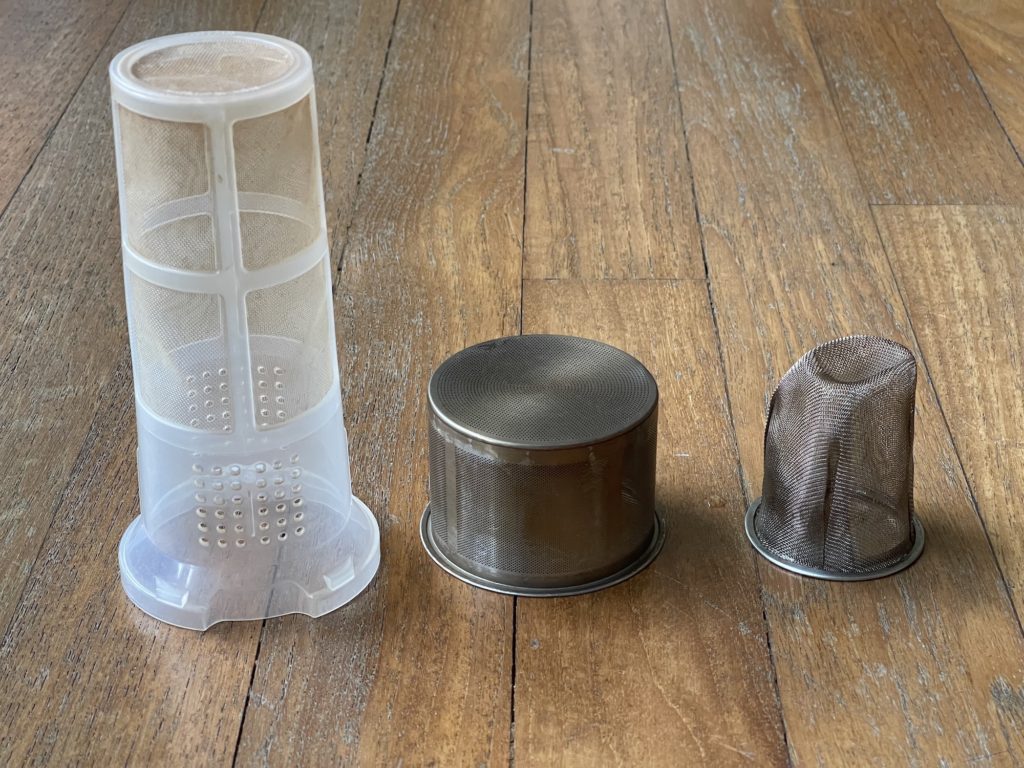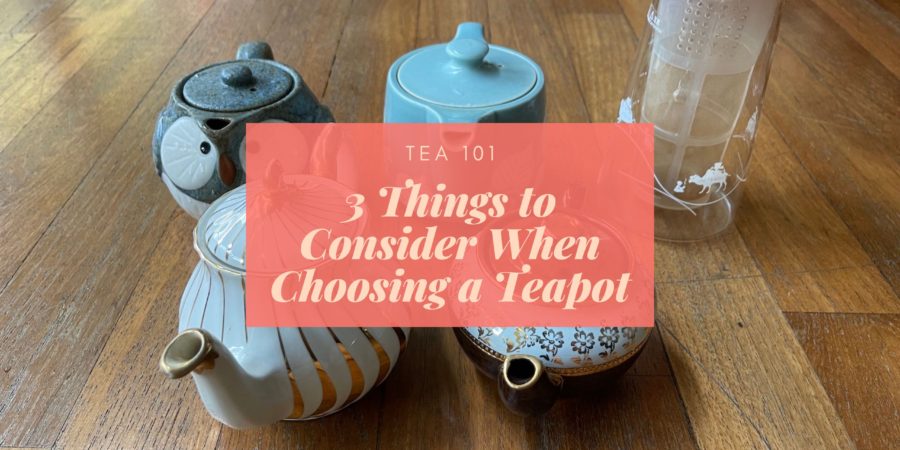Hello friends! I saw a really interesting post about teapots some time back, and I thought it might be helpful pick out 3 things you should be considering when buying a new teapot. Since there are quite a few ways to brew tea, I’m going to be very general and assume:
- You want one teapot to brew all sorts of teas (green, black, oolong, flavoured, straight, etc)
- You’ll be brewing primarily loose leaf teas (i.e. no tea bag)
I’m not really going to touch on size here – if you want to gongfu brew, then you’ll need to get a smaller pot, if you’re brewing for more than one at a go, you’ll need a bigger teapot and generally I think most people know the size that they want. But apart from how big a teapot is and how it looks, you should also be considering:
Material

If you’re planning to brew many different types of tea in one teapot, you might want to avoid unglazed teapots, since those can absorb flavour. But apart from unglazed clay teapots, there are quite a few other common options, such as:
- Iron – the most famous example of this is the tetsubin, or the Japanese iron teapot. These teapots are great at holding the temperature of the water, but they may give an iron-taste to the tea if there’s no enamel inside.
- Glass – glass teapots are pretty, since you can see the leaves or blooming tea unfurl from inside. They also hold heat pretty well and don’t impact the taste of the tea at all. However, glass may stain (it’s possible to get them off!).
- Ceramic – these are typically glazed, so they won’t impact the taste of the tea and are the most neutral.
By the way, glass and ceramic teapots can crack if you pour boiling water into them without warming up the pot (and you might ‘burn’ the tea). So it’s always a good idea to warm the pot up before you pour hot water in.
Teapot Spout

I’ll have to admit, the teapot spout is not something that I think about… until I’m pouring the tea! Some things that I learnt while searching about the topic include:
- Location of Spout: You’ll never be able to fill a teapot higher than the top of the spout so beware if the spout is too low (I think this will only be an issue if you’re buying teapots from someone who just started out making them)
- Spout tip: according to an article in Clay Times, a teapot will not dribble if the spout tip is horizontal or pointing downwards when the liquid begins to flow. So, look for a curved (or “sharp”) lip to the spout edge.
- Size of spout relative to the body of the teacup: a spout that is too big relative to the teapot means the teapot will easily lose its balance and tip forward. A spout that is too small/narrow will make pour the tea out really slowly.
Filter

In my ideal world, the filter of the teapot is built into the spout – I have a friend who added a tiny mesh to his teapots so that he doesn’t have to worry about leaves coming out! Plus, this method allows you to give the leaves maximum room to unfurl.
However, most teapots come with their own filters. For me, there are only two things I look for (and there’s one thing you may want to consider):
- The filters are big enough to allow your tea leaves to unfurl and big enough to hold enough tea leaves for the size of your pot.
- The filters are deep (especially for a tall teapot). I have a tea cup with a shallow filter, and that means I have to fill it to the brim if I want to brew tea – not ideal for times where I want less tea!
- For me, the material of the filter doesn’t make a difference to the taste for me. I find metal tea strainers to be really hot to touch, but it’s something you can get used to. If this is a worry for you, I’ve have one made out of what looks like plastic and have had no issues with it so far!
If your teapot doesn’t come with a filter, well there are several options. You could use a tea ball strainer (which I don’t recommend because unless you’re brewing CTC leaves, there may not be enough space for the tea), you could use a strainer when you pour the tea, or you could buy a filter that fits. I once bought a cheap teapot and found that it didn’t have a filter – I got around this by using a stocking tea filter (like the hong kong ones but shorter). This has the advantage of being stretchable and compressible, so I didn’t need to worry about the size of the lid and buying the correct-size filter.
Conclusion
Next time you’re buying a teapot, take a look at the material, spout, and filter! While these are by no means the only three things you could look at, I thought they were pretty easy to understand and could make a difference to the tea-brewing experience!

I’m not an expert, but if you have any questions (or any tips), please let me know – maybe one day I’ll write a “universiTEA” follow-up to this!
Main sources:

Oh, this is so interesting! I don’t have a teapot. I just boil the water and then pour it in a mug, and add the tea! (Is that awful?!) Clearly I need to do some research before investing in a teapot…. I rather thought you could just buy whatever!
Tea can be drunk any way! Your style could be “grandpa style”, especially if you just put the loose leaves in a mug – that’s how a lot of people in China drink it!
I used to buy teapots based on aesthetics but then I realised I gravitate to the same few pots!
I had NEVER even thought about the spout of the teapot!!!! 😱
I only think about it when it doesn’t pour well hahaha